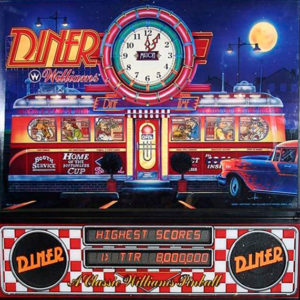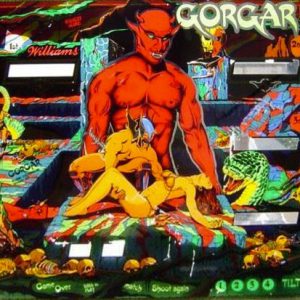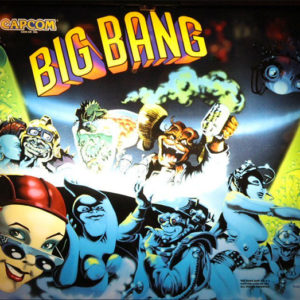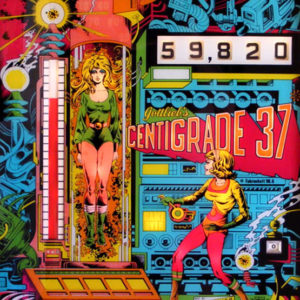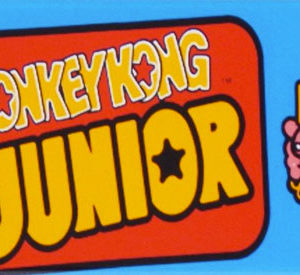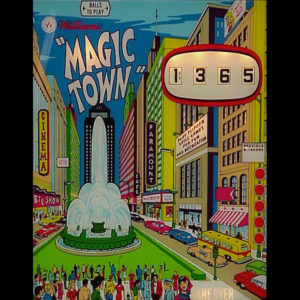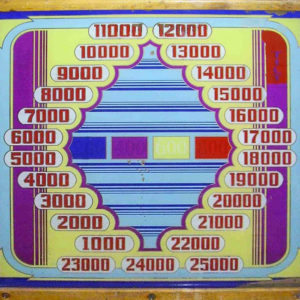-
This game was a breakthru game. It is the first-ever talking pinball machine. Games of this era had synthesized sound, but this game spoke. The speech wasn’t very clear or very wordy, as memory chips of this era couldn’t hold too much information compared to today’s games, but it was a sensation for Williams. The production run for the game was 14,000 units. It was designed by Barry Oursler with art by Constantino Mitchell. The top three rollover lanes would, if completed give up two, then three times bonus. The snake pit in the upper-left playfield has a magnet under it, which captures the ball for bonuses and Gorgar’s chance to use his seven-word vocabulary. Spelling out the word “Gorgar” makes the monster say his name and increases bonus values. This game also incorporates the background noise made famous in the Williams game Flash (in the museum). This time the background sound is of a heartbeat. It gets faster and faster as you advance.This game scores as the #10 most desirable game of the ’70s. It came out in August, designed by Ed Krynski and Allen Edwell with artwork by Gordon Morrison. Backbox animation is included in the game. A giant thermometer advances when drop targets are hit and by rolling over the rollovers. If the thermometer is advanced to the top, the special lights on the eject hole. A, B, C and D rollovers, if hit, advances the thermometer 5 advances. If a player completes all the letters, he gets 5,000 points in the eject hole. A double bonus feature is present also. All in all, a very fast-paced game. Artists, as a general rule, didn’t help design playfields. They were given the game mechanically more or less completed and had to invent the graphics and theme on their own.Donkey Kong Jr. is a 1982 arcade-style platform video game by Nintendo. It first appeared in arcades, and, over the course of the 1980s, was later released for a variety of platforms, most notably the Nintendo Entertainment System. The game’s title is written out as Donkey Kong Junior in the North American arcade version and various ports to non-Nintendo systems. Its eponymous star, Donkey Kong Jr., also called simply Junior[3] or abbreviated as DK Jr.,[4] is trying to rescue his father Donkey Kong, who has been imprisoned. Donkey Kong’s cage is guarded by Mario, in his only appearance as an antagonist in a video game. This game is the sequel to the video game Donkey Kong, which featured Mario as the hero and Junior’s father as the villain. Plot: Mario (known as Jumpman in Donkey Kong) has captured Donkey Kong and placed him in a cage as punishment for kidnapping his girlfriend Pauline.[5] Donkey Kong Jr. must rescue his father from Mario by working his way through a series of stages. Mario attempts to stop DK Jr. by releasing animals and putting obstacles in his way. When DK Jr. succeeds at the final level, Donkey Kong is freed and kicks Mario into the distance, leaving him to an unknown fate. Gameplay Like its predecessor, Donkey Kong, Jr. is an arcade-style platform game. There are a total of four stages, each with a unique theme. DK Jr. can run left and right, jump, and grab vines/chains/ropes to climb higher on the screen. He can slide down faster by holding only one vine, or climb faster by holding two. Enemies include “Snapjaws,” which resemble bear traps with eyes, bird-like creatures called “Nitpickers”, and “Sparks” that roam across the wiring in one of Mario’s hideouts. To pass the first three stages, DK Jr. must reach the key at the top. In the fourth stage, DK Jr. must push six keys into locks near the top of the stage to free Donkey Kong. After a brief cutscene, the player is taken back to the first stage at an increased difficulty. DK Jr. loses a life when he touches any enemy or projectile, falls too great a distance, or falls off the bottom of the screen. Additionally, he loses a life if the timer counts down to zero. The game ends when the player loses all of his or her lives.Pro Pool originated in December with 800 units being fabricated. This add-a-ball machine was designed by Ed Krynski with artwork by Gordon Morison. Two replay versions of the game were also made: a two-player version called Big Shot and a four-player version called Hot Shot. Obviously the theme of this game is the game of pool. The playfield is symmetrical and the way to win extra balls is by completing the left and/or right drop target battery. Doing so will lift the left and/or right wow rollovers for this award. The drop targets reset once the sequences are completed. Of course, an operator-adjusted score is another way to score a couple of balls. Back in the ‘70s, multiple balls or replays could be achieved on the game. Today, one free game on a current solid-state game is the common win. Operators have made it harder to achieve free games today as free games yield no income and only result in down time for the machine to earn coins in the till.
HOURS SUBJECT TO CHANGE! | Sun–Thurs: Noon–12am • Fri-Sat: Noon-2am | 19 NE 3rd Ave., Delray Beach, FL 33483 | (561) 266-3294 | Email Club




